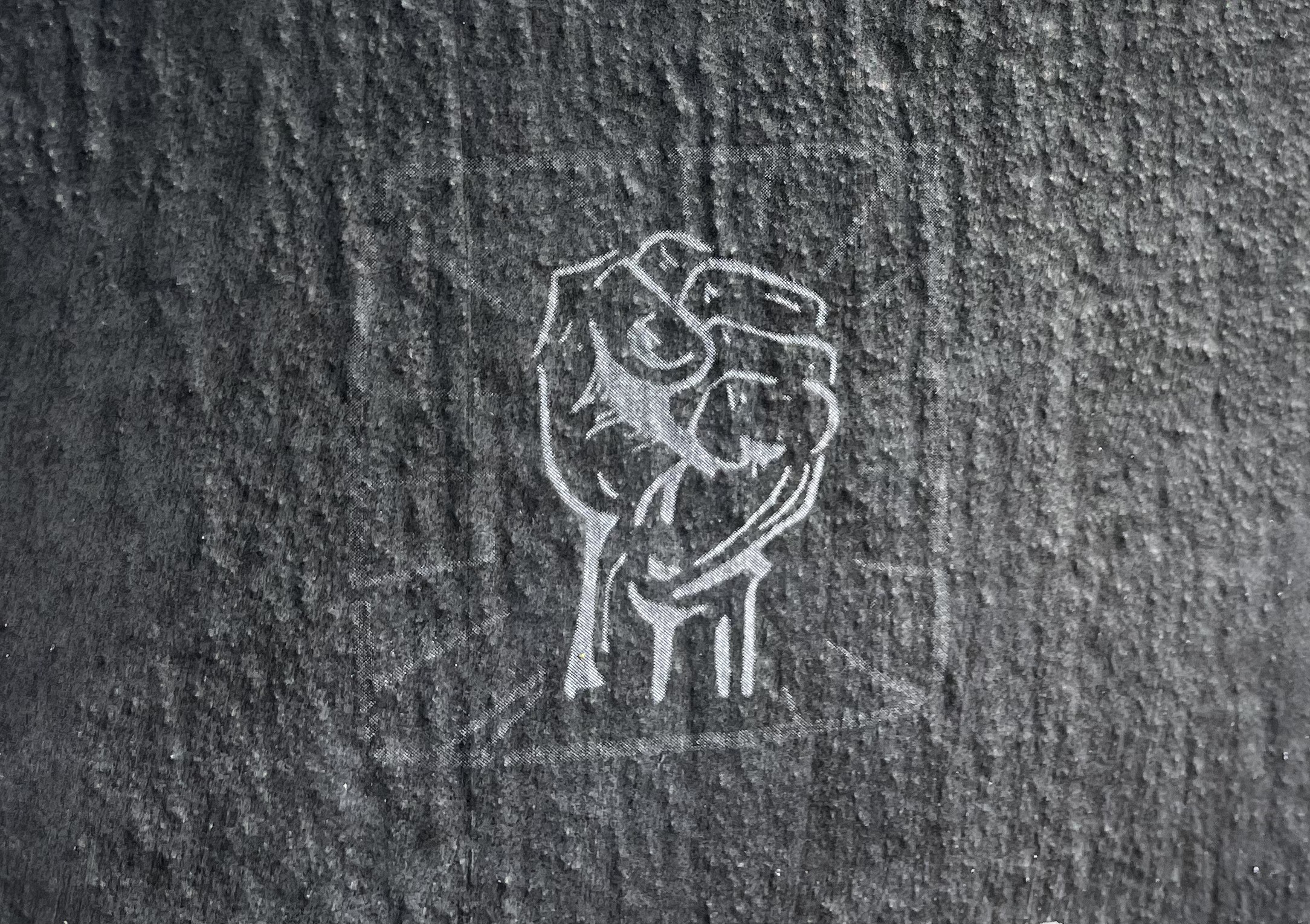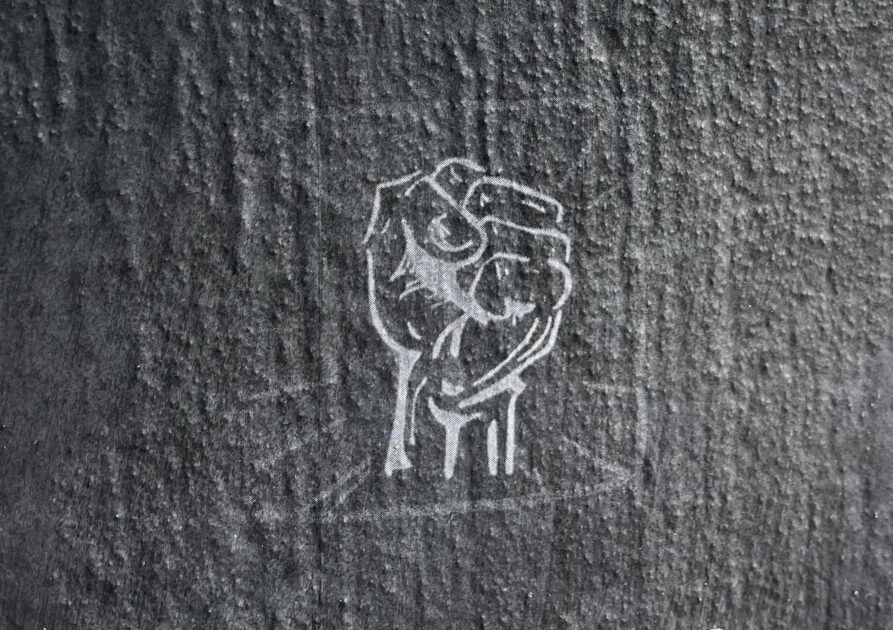






























































Photograph by Nathaniel St. Clair
Sunday, May 25, marks five years since George Floyd was murdered by Minneapolis police officer Derek Chauvin. Despite the flurry of statements, very little has changed. Indeed Trump’s Department of Justice is reversing modest reforms made.
Aside from a few retrospective posts in the news and from policymakers, particularly from Minnesota, Sunday was a day much like any other.
This is notable considering recent mobilization. On April 5, 2025, millions of people demonstrated across the country and indeed the world, loosely affiliated with Indivisible, organized by two former Democratic Congressional staffers. A smaller number again took to the streets on May 1 – known almost everywhere outside the U.S. as Labor Day, commemorating the 1886 Haymarket rebellion in Chicago that won us the right to the weekend. Visibly missing from the media coverage and grassroots organization of these last two worldwide protests were leaders doing specifically antiracist work, particularly combating antiblackness.
Since the beginning of Trump’s second administration, labor unions have been on the defensive. Hundreds of thousands of unionized federal employees are constantly threatened with contract termination by the Project 2025 playbook. Workers with the United States Agency for International Development were among the first to pack their bags, some having received their termination notice from halfway around the world.
This dystopia was far from foretold. We, Unions, let this happen.
We should have seen this coming, even before Teamsters president Sean O’Brien spoke at the Republican National Convention. When unions embrace a top-down or “least common denominator” approach instead of a bottom-up, inclusive antiracist approach, issues confronting BIPOC workers, and specifically Black workers, are swept aside, leaving white workers vulnerable to the manipulation and disinformation that corroborates their deeply ingrained antiblack beliefs, particularly to what Olúfẹ́mi O. Táíwò calls “elite capture” of identity politics.
“Either we go up together, or we go down together”
The fight for economic justice–which is why labor unions exist–is inextricably linked to the fight for racial justice.
It is no coincidence that Dr. King, one of the most iconic civil rights leaders, was assassinated while preparing to march with sanitation workers in Memphis who were on strike; in his last speech, “I’ve been to the mountaintop,” Dr. King implored collaboration and solidarity: “either we go up together, or we go down together.” Nor is it coincidental that the unrealized ‘racial awakening’ of 2020 was accompanied by a renewed energy for workplace unionization. Unions were designed to combat economic injustice–to redistribute wealth and power to those most marginalized in the workplace: workers.
The United States’ material wealth and cultural, social and political power is rooted in the economic exploitation of poor people and/or people of color. The theft of land from Indigenous people; the theft of Black, Asian, and immigrant labor for centuries; and the intentional denial of economic opportunities to these communities of color–but particularly Black folks–codified in laws and practices, form the bedrock of our nation’s wealth–and the resulting wealth gap. Hence unions exist to serve as vehicles of structural and institutional disruption. This is unequivocally antiracist work, for there can never be economic justice without racial justice, and vice versa. The power of the labor movement is derived from its ability to unite and build solidarity among workers–and this demands that unions engage directly with the issues that impact these workers and the communities they serve. As Charlene Carruthers, Chicago millennial activist and cofounder of Black Youth Project-100, argues, it is “all of us or none of us.”
“The Achilles Heel of the Labor Movement”
Unfortunately, though, unions, and the U.S. labor movement as a whole have not historically harnessed their collective power to oppose and defy racism–and they certainly have not consistently attempted to combat anti-Black racism: the deep-seated disdain for Black people that permeates every part of our society–even communities of color that also experience racism. On the contrary, unions have more often than not upheld white supremacy and been accomplices of bosses, capital, and imperialist agendas. Historians have acknowledged that the creation of “whiteness,” laws and practices that distinguished white indentured servants from their Black enslaved peers, were a direct response of the wealthy white elite who feared continued multiracial uprisings like that of Bacon’s Rebellion in the colony of Virginia. These elites deepened hereditary slavery for those of African descent while granting white farmers more rights and powers to distinguish them as different and of “higher status” than their Black enslaved counterparts.
The disdain for Black people and their well-being is not always spoken out loud; it doesn’t need to be. It is evident in the toleration of violence against Black bodies–from unparalleled police violence, to the violent systems of “discipline” in our schools that criminalize and punish Black children; to the ways in which Black mothers and children die at exponentially higher rates during childbirth. It is evident in the normalizing and even justifying of Black pain and suffering; in colorism that permeates Latin American and Asian cultures; in the ways Black people’s needs and concerns are discounted and even ignored in favor of more “universal issues”–despite the clear and well-documented history of violence, exploitation, and exclusion exacted upon Black people.
In modern day union history, this antiblackess has manifested in acts like more than 7,000 union members choosing to leave the American Federation of Teachers rather than integrate their local unions after the Brown v. Board of Education decision; to revered United Federation of Teachers (UFT) president Al Shanker leading a 36-day teachers’ strike in 1968 to quell the movement of Black and Brown parents to control their schools; to UFT’s refusal to pass a Black Lives Matter at School resolution in 2018 because it was too “divisive.” White supremacy has been, in education activist Pauline Lipman’s words, “the Achilles heel of the labor movement.”
Democrats, so-called progressives, and yes, so-called unionists, continually perpetuate antiblackness. After the majority of white voters and a significant minority of Latine and Asian voters lifted Donald Trump into his second presidency, the direction from many white labor leaders was to bring union members together; to listen to “both sides” in order to establish “common interests” so that we could “move forward together.” There was no call to address the antiblackness in our ranks. There was no acknowledgement that folks were willing to sacrifice the well-being of their Black, Latine, immigrant and transgender union “siblings” for the promise of spending a few less cents on eggs or gas–cynical promises summarily abandoned as Trump started a global trade war.
Even now, as the right unleashes its destructive Project 2025 agenda, alleged recommendations from a research group commissioned by the Democratic National Committee suggest de-prioritizing the federal attacks on DEI to amplify more “universal” (read: white) issues like tax cuts for the wealthy, tariffs, and cuts to entitlements like Social Security, Medicare and Medicaid, shouting “hands off!”
Indispensable
It is not that issues such as Social Security or Medicare aren’t of concern to Black folks. Indeed, Black folks are the most targeted. It just stings when labor clearly and intentionally omits how antiblackness played as significant a role in the election outcome as the economy. White and non-Black workers were willing to embrace racist rhetoric, policy agendas, etc. because they believed they would be sheltered and that Black folks would experience the most harm–which would be acceptable.
A mantra of unions is that “an injury to one is an injury to all.” But if that were truly the case, millions would line the streets daily over the violence and cruelty that Black folks face. Our society, and yes, our unions, have determined that Black folks, while reliable, are disposable.
Progressives rely on the fact that Black people will fight and resist injustice because they have to in order to survive. And every marginalized group benefits from that struggle. But when it is time to truly ally together to protect and/or follow Black folks, and by extension, all of humanity, virtue-signaling non-Black liberals often retreat into “least common denominator” or “unifying” politics.
Imagine being the most loyal base for Democrats and labor unions, but time and again have your priorities sidelined and outright dismissed for some faux form of “solidarity.” It is not only infuriating, it is exhausting. Little wonder why Black folks have been noticeably absent from post-election protests.
Black folks want to know that our lives, our well-being, our needs, our concerns, matter–not just when folks need our labor, our organizing and our resistance.
Until Black lives matter ALL the time, true solidarity is not possible. Because when we/they demonstrate that we/they don’t see or appreciate Black people’s full humanity, this chips away at Black folks’ empathy and compassion for non-Black people. In essence, we all become dehumanized.
Antiblackness makes us all vulnerable and unsafe. Just as we are now.
The opinions expressed in this article are solely those of the authors and should not be read as speaking for their affiliations.
The post Disrupting the Legacy: Why Unions Must Fight Antiblackness appeared first on CounterPunch.org.
This post was originally published on CounterPunch.org.